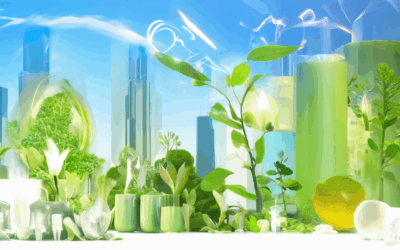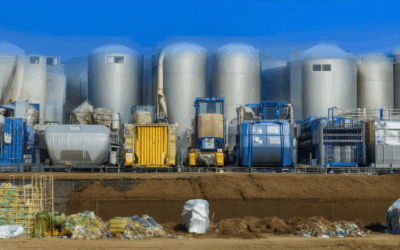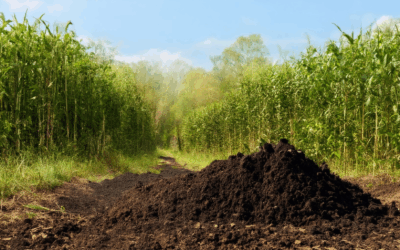Transforming waste into biochar represents a groundbreaking approach to sustainable living, offering a creative solution to reduce environmental impact while generating valuable resources. As interest in eco-friendly practices continues to grow, the process of converting ordinary waste into biochar has emerged as both a practical and innovative method for promoting environmental health. This transformative technique not only addresses the challenge of waste management but also contributes to enriching soil and fostering sustainable agricultural practices. By exploring the intricacies of biochar production, its environmental benefits, and the ongoing debates surrounding its adoption, this article delves into the potential of eco-friendly waste-to-biochar as a cornerstone of future sustainability efforts.
Biochar: A Promising Tool with Considerate Challenges
Introduction:
Biochar, derived from organic materials through pyrolysis, offers a sustainable alternative for soil amendments. By transforming waste into a valuable resource, biochar reduces waste and supports environmental health. However, its adoption is marked by several challenges that need thoughtful addressing.
Challenges and Solutions:
- Regulations and Quality Control:
- Inconsistencies: Global regulations vary, leading to quality variability.
- Solution: Establish uniform international standards, inspired by regions like Europe, to ensure consistent quality and efficacy.
- Land Use Concerns:
- Resource Competition: Biochar production competes with food production in land-scarce regions.
- Solution: Implement land-use policies that balance biochar production with food security, prioritizing regions with ample non-agricultural land.
- Carbon Footprint:
- Energy Intensity: High energy use in production can negate carbon benefits if reliant on fossil fuels.
- Solution: Invest in renewable energy sources for biochar production to reduce its carbon footprint.
- Environmental Impact:
- Misuse Risks: Improper application can harm ecosystems.
- Solution: Develop educational programs to teach proper usage techniques, emphasizing environmental stewardship.
- Complementary vs. Replacement Debate:
- Holistic Approach Needed: Biochar is most effective as part of broader sustainability strategies.
- Solution: Promote biochar as a complement to existing practices, encouraging integrated approaches.
- Cost and Accessibility:
- High Costs: Production expenses limit accessibility.
- Solution: Subsidize production or establish community-based initiatives to reduce costs, ensuring equitable access.
- Scientific and Expert Disagreements:
- Research Inconsistencies: Divergent expert opinions hinder adoption.
- Solution: Fund comprehensive, long-term research to provide conclusive evidence, fostering consensus among stakeholders.
Conclusion:
Biochar holds immense potential as a sustainable solution, yet its success hinges on overcoming regulatory, environmental, and socio-economic barriers. Through strategic planning, collaboration, and education, biochar can become a cornerstone of sustainable practices, enhancing agricultural resilience and ecological health.

How to Make Biochar from Waste
To create biochar from waste, follow these organized steps:
- Choose Suitable Feedstock: Select organic waste materials such as wood shavings, sawdust, agricultural residues, or manure. Avoid hazardous materials.
- Prepare Equipment: Use a metal container (e.g., a drum) with a lid and a heat-resistant lining. Attach a gas vent pipe for safe gas release. Utilize a reliable heat source like a propane burner or wood stove.
- Set Up Safety Measures: Ensure proper ventilation with a fan or open windows to prevent fume inhalation. Keep flammable materials away from heat sources.
- Heat the Material: Place the waste in the container, seal it, and heat at 500-600°C for about 30-60 minutes. Monitor the temperature and ensure minimal oxygen presence to encourage pyrolysis.
- Collect Biochar: After cooling, collect the black, porous biochar residue. Separate it from the remaining ash and gases.
- Optional Activation: Enhance biochar’s properties by adding steam or chemical activators to increase surface area and porosity, boosting its effectiveness as a soil amendment.
- Utilize Byproducts: Capture residual gases for potential reuse. Consider applications like composting or biogas production.
- Apply Biochar: Use biochar as a soil conditioner to improve fertility, reduce compaction, and suppress pests. It can also act as a carbon sink, aiding in carbon sequestration.
By following these steps, you can transform waste into a valuable resource, promoting sustainability and ecological benefits.
How to Make Biochar from Human Waste
Creating biochar from human waste involves a series of processes aimed at converting treated sewage sludge into a carbon-rich material. Here’s a step-by-step guide:
- Waste Treatment: Start with treated sewage sludge, often referred to as biosolids. These are typically generated during wastewater treatment processes.
- Biosolid Dewatering: Dehydrate the biosolids to reduce moisture content, making it suitable for further processing.
- Pyrolysis Process: Use a pyrolysis reactor to heat the biosolids in a low-oxygen environment. The temperature typically ranges between 300°C to 500°C, depending on the desired biochar properties.
- Carbonization: As the biomass decomposes, it releases carbon dioxide and other gases, leaving behind biochar, a fine black powder rich in carbon.
- Cooling and Storage: Allow the biochar to cool before storing it for use or further processing.
Key considerations include:
- Equipment Requirements: Pyrolysis reactors, heat management systems, and emission controls are essential for efficient biochar production.
- Environmental Safety: Proper ventilation and safety measures are necessary to handle potential hazards during the pyrolysis process.
- Sustainability: Converting human waste into biochar helps reduce landfill usage and greenhouse gas emissions, promoting a circular economy.
Example Implementation:
The Loganholme Wastewater Treatment Plant in Australia successfully converts 34,000 tonnes of biosolids annually into biochar using a gasification process. This initiative highlights the feasibility and environmental benefits of such practices.
By adopting similar methods, municipalities can effectively manage waste while contributing to global carbon sequestration efforts. However, scalability and operational efficiency remain key considerations for widespread adoption.

Is Biochar Environmentally Friendly?
Biochar is generally considered environmentally friendly due to its ability to sequester carbon and improve soil health. Here’s a breakdown of its environmental benefits and considerations:
Environmental Benefits of Biochar
- Carbon Sequestration: Biochar can store significant amounts of carbon, potentially offsetting greenhouse gas emissions. Each ton of biochar can capture approximately 1.5 tons of CO2.
- Soil Improvement: As a soil amendment, biochar enhances soil fertility by adding essential nutrients and improving water retention, reducing the need for synthetic fertilizers and minimizing environmental contamination.
- Sustainable Material Use: Produced from organic waste or renewable biomass, biochar diverts materials from landfills and offers a sustainable alternative to conventional fuels.
Considerations for Environmental Friendliness
- Production Practices: The environmental impact of biochar depends on the sustainability of its production. Sustainable practices, such as using crop residues or tree trimmings, are crucial to minimize resource depletion.
- Energy Efficiency: High energy consumption during production can pose environmental challenges if not managed efficiently.
- Regulatory Standards: Adherence to guidelines set by organizations like the International Biochar Initiative ensures responsible production and use, enhancing eco-friendliness.
Conclusion
Biochar can be environmentally friendly when produced and applied responsibly. Its ability to sequester carbon and promote sustainable agriculture makes it a promising tool for environmental stewardship. However, careful consideration of production methods and material sources is essential to maximize its positive impact.
Key Takeaways
- Biochar effectively captures carbon, contributing to climate goals.
- It enhances soil health, reducing reliance on harmful fertilizers.
- Sustainable production practices are vital to its environmental benefits.

Why is Biochar Controversial?
The controversy surrounding biochar arises from several interconnected factors, each contributing to the ongoing discussions about its role in sustainable practices:
- Production Regulations and Quality Control :
Biochar production lacks uniform global regulations, leading to variability in product quality. While some regions, like parts of Europe, have established strict guidelines, other areas may lack regulation, resulting in inconsistent biochar compositions and effectiveness. - Land Use Concerns :
The production of biochar requires substantial amounts of biomass, often competing with land used for food production or other agricultural purposes. This can lead to land-use conflicts, particularly in regions with limited arable land or high agricultural demand. - Carbon Sequestration Efficiency :
While biochar is effective at sequestering carbon, concerns arise about its overall carbon footprint. The energy-intensive production process and potential reliance on fossil fuels during manufacturing can negate some of its carbon-sequestration benefits. - Potential Misuse and Environmental Impact :
Although biochar can benefit agriculture as a soil amendment, improper application or misuse can harm ecosystems and crop productivity. There are also uncertainties regarding long-term effects on soil health and fertility. - Complementary vs. Replacement Debate :
Biochar is often viewed as a complementary tool rather than a standalone solution for carbon sequestration. Its effectiveness may vary depending on location and application methods, sparking discussions about its role alongside traditional practices like afforestation. - Cost and Accessibility Issues :
High production costs and limited availability can restrict access to biochar, raising concerns about equity and accessibility for those in need of sustainable solutions. - Scientific and Expert Disagreements :
Opinions among scientists and experts differ, with some viewing biochar as a promising solution and others remaining skeptical due to limited or conflicting research findings.
These multifaceted issues highlight the complexity of biochar’s role in sustainable practices, contributing to the ongoing debate about its adoption and implementation.
The Negatives of Biochar
Biochar, while offering numerous benefits, also presents several drawbacks:
- High Production Costs:** The process of creating biochar, particularly through pyrolysis, requires significant energy input, which can make it more expensive than traditional fertilizers.
- Environmental Impact:** The production of biochar can emit greenhouse gases like CO2, though modern facilities often aim to minimize these emissions. Improper production may lead to releases of other pollutants.
- Quality Variability:** The effectiveness of biochar can vary based on the source material and production method, leading to inconsistent results.
- Competition with Established Products:** Biochar faces competition from long-standing chemical fertilizers, which many farmers and gardeners are already familiar with and trust.
- Regulatory and Adoption Challenges:** Biochar’s acceptance is hindered by varying regional regulations and lack of widespread certification standards, making adoption uncertain for some users.
- Activation Requirement:** To enhance functionality, biochar often needs activation, an additional treatment that adds complexity and cost to its production.

Why Are People Against Biochar?
People may have various reasons for opposing biochar, ranging from concerns about its effectiveness to worries about potential downsides. Here are some common arguments:
- Economic Concerns:** Biochar production can be costly, potentially making it less accessible compared to conventional fertilizers. This economic barrier can hinder its adoption, particularly among smaller-scale farmers or households.
- Contamination Risks:** Biochar has the ability to adsorb pollutants such as pesticides, herbicides, heavy metals, and volatile organic compounds. If not properly produced or managed, this could lead to contamination in soil and water systems, raising safety concerns.
- Lack of Awareness:** A lack of understanding about what biochar is and how it functions can lead to skepticism. Without proper education on its benefits and limitations, people may dismiss it as just another agricultural trend.
- Pest Attraction:** Biochar’s carbon-rich nature can act as a magnet for pests, including insects and microorganisms. This can pose challenges for farmers attempting to grow crops, as it may lead to increased pest activity if not managed appropriately.
- Resource Competition:** The production of biochar requires significant amounts of biomass, which can divert resources away from other uses, such as animal feed or biogas production. This competition for resources can create tensions, particularly in regions with limited supplies.
- Regulatory Issues:** Without standardized regulations, biochar products may vary in quality and consistency. This variability can make it difficult for consumers and farmers to trust biochar as a reliable solution for their needs.
- Perceived Lack of Benefits:** Some critics argue that biochar does not deliver the environmental benefits it promises. If scientific studies indicate that its impact is overstated or inconsistent, this could lead to skepticism among those who are already committed to established practices.
Addressing these concerns through improved regulation, education, and research could help mitigate opposition and foster greater acceptance of biochar as a sustainable solution.




0 Comments